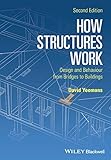How structures work : design and behaviour from bridges to buildings / David Yeomans
Material type: TextPublisher: Chichester, West Sussex, United Kingdom : Wiley Blackwell, 2016Edition: 2nd editionDescription: xv, 255 pages : illustrations ; 25 cmContent type:
TextPublisher: Chichester, West Sussex, United Kingdom : Wiley Blackwell, 2016Edition: 2nd editionDescription: xv, 255 pages : illustrations ; 25 cmContent type: - text
- computer
- online resource
- 1119012279
- 9781119012276
- 624.1 23
- TA633 .Y46 2016
| Item type | Current library | Call number | Status | Date due | Barcode | |
|---|---|---|---|---|---|---|
| E-Resources | Main Library E-Resources | 624.1 Y46 (Browse shelf(Opens below)) | Available | E003059 |
Includes bibliographical references and index
Brackets and bridges -- Stiffening a beam : girder bridges -- Arches and suspension bridges -- Bringing the loads to the ground : the structural scheme -- Safe as houses? : walls -- Frames : a problem of stability -- Floors and beams : deflections and bending moments -- Providing shelter : roofs -- Structures in a three-dimensional world -- Materials and workmanship
Structural engineering is central to the design of a building. How the building behaves when subjected to various forces - the weight of the materials used to build it, the weight of the occupants or the traffic it carries, the force of the wind etc - is fundamental to its stability. The alliance between architecture and structural engineering is therefore critical to the successful design and completion of the buildings and infrastructure that surrounds us. Yet structure is often cloaked in mathematics which many architects and surveyors find difficult to understand. How Structures Work has been written to explain the behaviour of structures in a clear way without resorting to complex mathematics. This new edition includes a new chapter on construction materials, and significant revisions to, and reordering of the existing chapters. It is aimed at all who require a good qualitative understanding of structures and their behaviour, and as such will be of benefit to students of architecture, architectural history, building surveying and civil engineering. The straightforward, non-mathematical approach ensures it will also be suitable for a wider audience including building administrators, archaeologists and the interested layman
There are no comments on this title.

